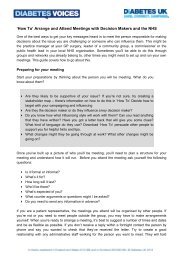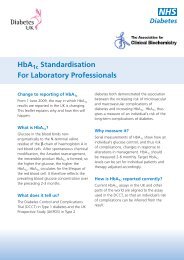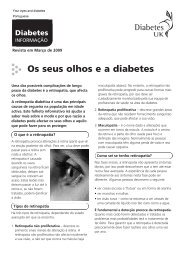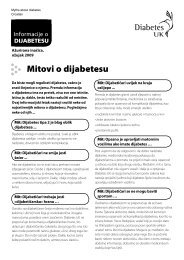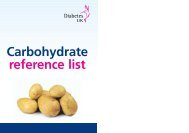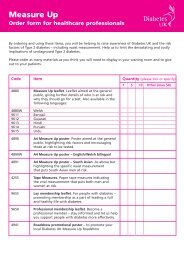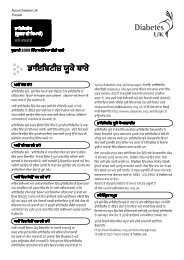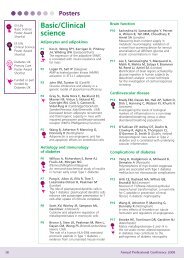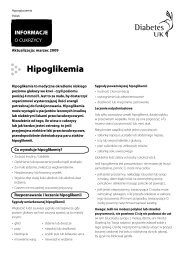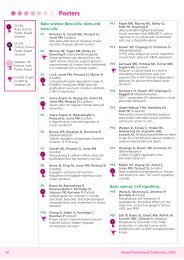The Hospital Management of Hypoglycaemia in ... - NHS Diabetes
The Hospital Management of Hypoglycaemia in ... - NHS Diabetes
The Hospital Management of Hypoglycaemia in ... - NHS Diabetes
Create successful ePaper yourself
Turn your PDF publications into a flip-book with our unique Google optimized e-Paper software.
<strong>The</strong> <strong>Hospital</strong> <strong>Management</strong> <strong>of</strong><br />
<strong>Hypoglycaemia</strong> <strong>in</strong> Adults<br />
with <strong>Diabetes</strong> Mellitus<br />
March 2010<br />
Support<strong>in</strong>g, Improv<strong>in</strong>g, Car<strong>in</strong>g
Statement for Inpatient Guidel<strong>in</strong>es<br />
This guidel<strong>in</strong>e has been developed to advise the treatment and management <strong>of</strong> <strong>The</strong> <strong>Hospital</strong> <strong>Management</strong><br />
<strong>of</strong> <strong>Hypoglycaemia</strong> <strong>in</strong> Adults with <strong>Diabetes</strong> Mellitus.<br />
<strong>The</strong> guidel<strong>in</strong>e recommendations have been developed by a multidiscipl<strong>in</strong>ary team led by the Jo<strong>in</strong>t British<br />
<strong>Diabetes</strong> Society (JBDS) and <strong>in</strong>clud<strong>in</strong>g representation from <strong>Diabetes</strong> UK. People with diabetes have been<br />
<strong>in</strong>volved <strong>in</strong> the development <strong>of</strong> the guidel<strong>in</strong>es via stakeholder events organised by <strong>Diabetes</strong> UK.<br />
It is <strong>in</strong>tended that the guidel<strong>in</strong>e will be useful to cl<strong>in</strong>icians and service commissioners <strong>in</strong> plann<strong>in</strong>g,<br />
organis<strong>in</strong>g and deliver<strong>in</strong>g high quality diabetes <strong>in</strong>patient care. <strong>The</strong>re rema<strong>in</strong>s, however, an <strong>in</strong>dividual<br />
responsibility <strong>of</strong> healthcare pr<strong>of</strong>essionals to make decisions appropriate to the circumstance <strong>of</strong> the<br />
<strong>in</strong>dividual patient, <strong>in</strong>formed by the patient and/or their guardian or carer and tak<strong>in</strong>g full account <strong>of</strong> their<br />
medical condition and treatment.<br />
When implement<strong>in</strong>g this guidel<strong>in</strong>e full account should be taken <strong>of</strong> the local context and <strong>in</strong> l<strong>in</strong>e with<br />
statutory obligations required <strong>of</strong> the organisation and <strong>in</strong>dividual. No part <strong>of</strong> the guidel<strong>in</strong>e should be<br />
<strong>in</strong>terpreted <strong>in</strong> a way that would know<strong>in</strong>gly put people, patient or cl<strong>in</strong>ician at risk.<br />
We would like to thank the service user representatives whose <strong>in</strong>put has <strong>in</strong>formed the development <strong>of</strong><br />
these guidel<strong>in</strong>es.
Authors:<br />
Debbie Stanisstreet (RGN), East & North Hertfordshire <strong>NHS</strong> Trust<br />
Esther Walden (RGN), Norfolk and Norwich University <strong>Hospital</strong>s <strong>NHS</strong> Foundation Trust<br />
Christ<strong>in</strong>e Jones, Norfolk and Norwich University <strong>Hospital</strong>s <strong>NHS</strong> Foundation Trust<br />
Dr Alex Gravel<strong>in</strong>g, Royal Infirmary <strong>of</strong> Ed<strong>in</strong>burgh<br />
Contributors:<br />
Pr<strong>of</strong>essor Stephanie Amiel, K<strong>in</strong>g’s College <strong>Hospital</strong> <strong>NHS</strong> Foundation Trust<br />
Dr Clare Crowley, Oxford Radcliffe <strong>Hospital</strong>s <strong>NHS</strong> Trust<br />
Dr Ketan Dhatariya, Norfolk and Norwich University <strong>Hospital</strong>s <strong>NHS</strong> Foundation Trust<br />
Pr<strong>of</strong>essor Brian Frier, Royal Infirmary <strong>of</strong> Ed<strong>in</strong>burgh<br />
Dr Rifat Malik, K<strong>in</strong>g’s College <strong>Hospital</strong> <strong>NHS</strong> Foundation Trust<br />
Distributed and <strong>in</strong>corporated comments from:<br />
<strong>Diabetes</strong> Inpatient Specialist Nurse (DISN) UK Group membership<br />
Jo<strong>in</strong>t British <strong>Diabetes</strong> Societies (JBDS) Inpatient Care Work<strong>in</strong>g Group members<br />
<strong>NHS</strong> <strong>Diabetes</strong><br />
<strong>Diabetes</strong> UK<br />
<strong>Diabetes</strong> UK User Group<br />
Association British Cl<strong>in</strong>ical Diabetologists (ABCD)<br />
<strong>NHS</strong> Institute <strong>of</strong> Improvement and Innovation, Th<strong>in</strong>kGlucose team<br />
<strong>The</strong> <strong>Diabetes</strong> <strong>Management</strong> & Education Group <strong>of</strong> the British Dietetic Association<br />
United K<strong>in</strong>gdom Cl<strong>in</strong>ical Pharmacy Association (UKCPA) <strong>Diabetes</strong> Committee<br />
Guild <strong>of</strong> Healthcare Pharmacists<br />
Wider distribution:<br />
Royal College <strong>of</strong> Nurs<strong>in</strong>g<br />
Royal College <strong>of</strong> Physicians<br />
3
Foreword<br />
<strong>Hypoglycaemia</strong> is the most feared complication <strong>of</strong> <strong>in</strong>sul<strong>in</strong> therapy, present<strong>in</strong>g an <strong>in</strong>creas<strong>in</strong>gly important<br />
problem for hospital services. A grow<strong>in</strong>g prevalence <strong>of</strong> diabetes <strong>in</strong> the community has been accompanied<br />
by an even greater <strong>in</strong>crease <strong>of</strong> diabetes <strong>in</strong> hospitalised patients such that one <strong>in</strong> six <strong>in</strong>patients has<br />
diabetes. Furthermore, more than half <strong>of</strong> these are be<strong>in</strong>g treated with <strong>in</strong>sul<strong>in</strong> or an oral agent that may<br />
cause hypoglycaemia. Approximately one <strong>in</strong> four people with diabetes suffers a hypoglycaemic episode<br />
dur<strong>in</strong>g their hospital stay. This has serious consequences as <strong>in</strong>patient hypoglycaemia not only <strong>in</strong>creases<br />
length <strong>of</strong> stay but is associated with an <strong>in</strong>creased mortality.<br />
Prevention <strong>of</strong> hypoglycaemia and its prompt and effective treatment is therefore essential. This is the aim<br />
<strong>of</strong> this guidel<strong>in</strong>e. It has been written by practic<strong>in</strong>g cl<strong>in</strong>icians and draws from their experiences <strong>of</strong> manag<strong>in</strong>g<br />
hypoglycaemia <strong>in</strong> UK hospitals. It outl<strong>in</strong>es the risk factors for, and causes <strong>of</strong> hypoglycaemia <strong>in</strong> hospital,<br />
recognis<strong>in</strong>g that these are <strong>of</strong>ten quite different from those <strong>in</strong> the community e.g. a dislodged enteral<br />
feed<strong>in</strong>g tube <strong>in</strong> a patient receiv<strong>in</strong>g <strong>in</strong>sul<strong>in</strong>. It gives comprehensive and detailed advice on the management<br />
<strong>of</strong> hypoglycaemia <strong>in</strong> a variety <strong>of</strong> cl<strong>in</strong>ical situations from the fully conscious, to the conscious but confused,<br />
through to the unconscious patient. <strong>The</strong>re is a recommendation that hypoglycaemic boxes should be<br />
available <strong>in</strong> all hospital trusts and a valuable list <strong>of</strong> what should be <strong>in</strong>cluded <strong>in</strong> such boxes. Audit <strong>of</strong> the<br />
management <strong>of</strong> hypoglycaemia is encouraged and a useful audit tool is provided.<br />
<strong>The</strong> guidel<strong>in</strong>e is clearly written and accompanied by a practical and easy to follow visual treatment<br />
algorithm which many will f<strong>in</strong>d useful.<br />
<strong>The</strong> authors should feel proud <strong>of</strong> their achievement which I recommend to the diabetes hospital<br />
community.<br />
Dr G Rayman<br />
<strong>NHS</strong> <strong>Diabetes</strong> Cl<strong>in</strong>ical Lead for Inpatient <strong>Diabetes</strong> Care<br />
Anna Morton<br />
Director - <strong>NHS</strong> <strong>Diabetes</strong><br />
4
Contents<br />
Introduction 7<br />
Cl<strong>in</strong>ical features 8<br />
Risk factors for hypoglycaemia 8<br />
Potential causes <strong>of</strong> <strong>in</strong>patient hypoglycaemia 9<br />
<strong>Management</strong> <strong>of</strong> hypoglycaemia 10<br />
Treatment <strong>of</strong> hypoglycaemia 10<br />
A. Adults who are conscious, orientated and able to swallow 11<br />
B. Adults who are conscious but confused and able to swallow 12<br />
C. Adults who are unconscious or hav<strong>in</strong>g seizures 13<br />
D. Adults who are ‘Nil by Mouth’ 14<br />
E. Adults requir<strong>in</strong>g enteral feed<strong>in</strong>g 15<br />
When hypoglycaemia has been successfully treated 16<br />
Audit Standards 17<br />
Acknowledgements 18<br />
Guidel<strong>in</strong>e update 18<br />
References 19<br />
Further read<strong>in</strong>g 20<br />
Appendices<br />
Appendix 1 – List <strong>of</strong> <strong>in</strong>sul<strong>in</strong>s currently available 21<br />
Appendix 2 – Example <strong>of</strong> contents <strong>of</strong> hypo box 22<br />
Appendix 3 – <strong>Hypoglycaemia</strong> audit form 23<br />
Appendix 4 - Injectable medic<strong>in</strong>es monograph 25<br />
Inserts<br />
Traffic light algorithm for the treatment <strong>of</strong> hypoglycaemia<br />
Flow chart for the treatment <strong>of</strong> hypoglycaemia<br />
5
Introduction<br />
This guidel<strong>in</strong>e is for the management <strong>of</strong><br />
hypoglycaemia <strong>in</strong> adults (aged 16 years or older)<br />
with diabetes mellitus with<strong>in</strong> the hospital sett<strong>in</strong>g.<br />
This guidel<strong>in</strong>e is designed to be nurse led, however<br />
none <strong>of</strong> the <strong>in</strong>travenous (IV) glucose preparations<br />
suggested can be given by a nurse without<br />
prescription (currently under review), or a locally<br />
agreed patient group directive (PGD). <strong>The</strong> authors<br />
recommend the IV glucose preparation chosen is<br />
prescribed on an ‘as required’ (PRN) basis for all<br />
patients with diabetes. Expert op<strong>in</strong>ion would<br />
suggest that the use <strong>of</strong> hyperosmolar solutions<br />
such as 50% glucose <strong>in</strong>crease the risk <strong>of</strong><br />
extravasation <strong>in</strong>jury. Furthermore, Moore et al<br />
(2005) found that the smaller aliquots used to<br />
deliver 10% glucose resulted <strong>in</strong> lower post<br />
treatment glucose levels. For these reasons 10%<br />
or 20% glucose solutions are preferred to the<br />
previous commonplace use <strong>of</strong> 50% glucose. If<br />
agreed locally, glucagon may be given without<br />
prescription <strong>in</strong> an emergency for the purpose <strong>of</strong><br />
sav<strong>in</strong>g a life (Medic<strong>in</strong>es, Ethics & Practice 2009).<br />
Please note that <strong>in</strong>tramuscular (IM) glucagon is<br />
only licensed for the treatment <strong>of</strong> <strong>in</strong>sul<strong>in</strong> overdose,<br />
although is sometimes used <strong>in</strong> the treatment <strong>of</strong><br />
hypoglycaemia <strong>in</strong>duced by sulphonylurea therapy.<br />
All nurses must work with<strong>in</strong> the Nurs<strong>in</strong>g and<br />
Midwifery Council (NMC) pr<strong>of</strong>essional code <strong>of</strong><br />
conduct and work with<strong>in</strong> their own competencies.<br />
This guidel<strong>in</strong>e is designed to enable adaptation to<br />
suit local practice where required.<br />
<strong>Hypoglycaemia</strong> <strong>in</strong> Adults with <strong>Diabetes</strong><br />
<strong>Hypoglycaemia</strong> is the commonest side effect <strong>of</strong><br />
<strong>in</strong>sul<strong>in</strong> and sulphonylureas <strong>in</strong> the treatment <strong>of</strong><br />
diabetes and presents a major barrier to<br />
satisfactory long term glycaemic control.<br />
Metform<strong>in</strong>, thiazolid<strong>in</strong>ediones, DPP-4 <strong>in</strong>hibitors<br />
and GLP-1 analogues prescribed without <strong>in</strong>sul<strong>in</strong> or<br />
sulphonylurea therapy are unlikely to result <strong>in</strong><br />
hypoglycaemia. <strong>Hypoglycaemia</strong> results from an<br />
imbalance between glucose supply, glucose<br />
utilisation and current <strong>in</strong>sul<strong>in</strong> levels.<br />
<strong>Hypoglycaemia</strong> should be excluded <strong>in</strong> any person<br />
with diabetes who is acutely unwell, drowsy,<br />
unconscious, unable to co-operate, present<strong>in</strong>g<br />
with aggressive behaviour or seizures.<br />
7<br />
At least 10% <strong>of</strong> <strong>in</strong>patients <strong>in</strong> the UK have known<br />
diabetes, this <strong>in</strong>creases to 25% <strong>in</strong> some high risk<br />
groups (Sampson et al 2007). <strong>The</strong> hospital<br />
environment presents additional obstacles to the<br />
ma<strong>in</strong>tenance <strong>of</strong> good glycaemic control and the<br />
avoidance <strong>of</strong> hypoglycaemia. <strong>Hypoglycaemia</strong><br />
occurs <strong>in</strong> 7.7% <strong>of</strong> admissions and results <strong>in</strong><br />
<strong>in</strong>creased length <strong>of</strong> stay and mortality rates<br />
(Turch<strong>in</strong> et al 2009).<br />
Def<strong>in</strong>ition<br />
<strong>Hypoglycaemia</strong> is a lower than normal level <strong>of</strong><br />
blood glucose. It can be def<strong>in</strong>ed as “mild” if the<br />
episode is self treated and “severe” if assistance by<br />
a third party is required (DCCT, 1993). For the<br />
purposes <strong>of</strong> people with diabetes requir<strong>in</strong>g<br />
hospital admission, any blood glucose less than<br />
4.0mmol/L should be treated.<br />
Frequency<br />
People with type 1 diabetes mellitus (T1DM)<br />
experience around two episodes <strong>of</strong> mild<br />
hypoglycaemia per week. Studies such as the<br />
DCCT excluded patients with a history <strong>of</strong> severe<br />
hypoglycaemia and reported lower <strong>in</strong>cidences <strong>of</strong><br />
hypoglycaemia than would be observed <strong>in</strong> an<br />
unselected group <strong>of</strong> patients. In unselected<br />
populations, the annual prevalence <strong>of</strong> severe<br />
hypoglycaemia has been reported consistently at<br />
30-40% <strong>in</strong> several large studies (Strachan, 2007).<br />
Severe hypoglycaemia is less common <strong>in</strong> people<br />
with <strong>in</strong>sul<strong>in</strong> treated type 2 diabetes mellitus<br />
(T2DM) but still represents a significant cl<strong>in</strong>ical<br />
problem. Patients with <strong>in</strong>sul<strong>in</strong> treated T2DM are<br />
more likely to require hospital admission for severe<br />
hypoglycaemia than those with T1DM (30% versus<br />
10% <strong>of</strong> episodes). <strong>The</strong> risk <strong>of</strong> hypoglycaemia with<br />
sulphonylurea therapy is <strong>of</strong>ten underestimated and<br />
as a consequence <strong>of</strong> the duration <strong>of</strong> action <strong>of</strong> the<br />
tablets, is frequently prolonged. Elderly patients or<br />
those with renal impairment are at particular risk<br />
<strong>of</strong> hypoglycaemia. <strong>The</strong> UK <strong>Hypoglycaemia</strong> Study<br />
showed equivalent levels <strong>of</strong> severe hypoglycaemia<br />
<strong>in</strong> those treated with sulphonylureas compared<br />
with <strong>in</strong>sul<strong>in</strong> therapy <strong>of</strong> less than two years duration<br />
(UK <strong>Hypoglycaemia</strong> Study, 2007).
Cl<strong>in</strong>ical Features<br />
<strong>The</strong> symptoms <strong>of</strong> hypoglycaemia warn an<br />
<strong>in</strong>dividual <strong>of</strong> its onset and vary considerably<br />
between <strong>in</strong>dividuals. Autonomic symptoms are<br />
generated by the activation <strong>of</strong> the sympathoadrenal<br />
system and neuroglycopenic symptoms are<br />
the result <strong>of</strong> cerebral glucose deprivation.<br />
<strong>The</strong> bra<strong>in</strong> is dependent on a cont<strong>in</strong>uous supply <strong>of</strong><br />
Table 1: Ed<strong>in</strong>burgh <strong>Hypoglycaemia</strong> Scale<br />
Risk Factors for <strong>Hypoglycaemia</strong><br />
Be aware that the follow<strong>in</strong>g can also precipitate<br />
hypoglycaemia:<br />
Concurrent use <strong>of</strong> drugs with hypoglycaemic<br />
agents e.g. warfar<strong>in</strong>, qu<strong>in</strong><strong>in</strong>e, salicylates,<br />
fibrates, sulphonamides (<strong>in</strong>clud<strong>in</strong>g<br />
cotrimoxazole), monoam<strong>in</strong>e oxidase <strong>in</strong>hibitors,<br />
8<br />
circulat<strong>in</strong>g glucose as the substrate to fuel cerebral<br />
metabolism and support cognitive performance.<br />
If blood glucose levels fall sufficiently, cognitive<br />
dysfunction is <strong>in</strong>evitable (Evans & Amiel, 2002).<br />
<strong>The</strong> 11 most common symptoms were used to<br />
form the Ed<strong>in</strong>burgh <strong>Hypoglycaemia</strong> Scale and are<br />
reproduced <strong>in</strong> the table below (Deary et al 1993).<br />
Autonomic Neuroglycopenic General malaise<br />
Sweat<strong>in</strong>g Confusion Headache<br />
Palpitations Drows<strong>in</strong>ess Nausea<br />
Shak<strong>in</strong>g Odd behaviour<br />
Hunger Speech difficulty<br />
Incoord<strong>in</strong>ation<br />
Table 2: Risk Factors for <strong>Hypoglycaemia</strong><br />
Medical issues<br />
Tight glycaemic control<br />
Previous history <strong>of</strong> severe hypoglycaemia<br />
Undetected nocturnal hypoglycaemia<br />
Long duration <strong>of</strong> diabetes<br />
Poor <strong>in</strong>jection technique<br />
Impaired awareness <strong>of</strong> hypoglycaemia<br />
Preced<strong>in</strong>g hypoglycaemia (less than<br />
3.5mmol/L)<br />
Severe hepatic dysfunction<br />
Renal dialysis therapy<br />
Impaired renal function<br />
Inadequate treatment <strong>of</strong> previous<br />
hypoglycaemia<br />
Term<strong>in</strong>al illness<br />
Lifestyle issues<br />
Increased exercise (relative to usual)<br />
Irregular lifestyle<br />
Increas<strong>in</strong>g age<br />
Alcohol<br />
Early pregnancy<br />
Breast feed<strong>in</strong>g<br />
Injection <strong>in</strong>to areas <strong>of</strong> lipohypertrophy (lumpy<br />
sites)<br />
Inadequate blood glucose monitor<strong>in</strong>g<br />
Reduced carbohydrate <strong>in</strong>take<br />
Food malabsorption e.g.gastroenteritis,<br />
coeliac disease<br />
NSAIDs, probenecid, somatostat<strong>in</strong> analogues,<br />
SSRIs. Do not stop or withhold medication,<br />
discuss with the medical team or pharmacist.<br />
Loss <strong>of</strong> anti-<strong>in</strong>sul<strong>in</strong> hormone function (Addison’s<br />
disease, growth hormone deficiency,<br />
hypothyroidism, hypopituitarism)
Potential causes <strong>of</strong> Inpatient<br />
<strong>Hypoglycaemia</strong><br />
Common causes <strong>of</strong> <strong>in</strong>patient hypoglycaemia are<br />
listed <strong>in</strong> table 3. One <strong>of</strong> the most serious and<br />
common causes <strong>of</strong> <strong>in</strong>patient hypoglycaemia is<br />
<strong>in</strong>sul<strong>in</strong> prescription error <strong>in</strong>clud<strong>in</strong>g:<br />
Misread<strong>in</strong>g poorly written prescriptions – when<br />
‘U’ is used for units (4U becom<strong>in</strong>g 40 units)<br />
Table 3: Potential causes <strong>of</strong> Inpatient <strong>Hypoglycaemia</strong><br />
Medical issues<br />
Inappropriate use <strong>of</strong> ‘stat’ or ‘PRN’ quick act<strong>in</strong>g<br />
<strong>in</strong>sul<strong>in</strong><br />
Acute discont<strong>in</strong>uation <strong>of</strong> long term steroid therapy<br />
Recovery from acute illness/stress<br />
Mobilisation after illness<br />
Major amputation <strong>of</strong> a limb<br />
Inappropriately timed diabetes medication for<br />
meal/enteral feed<br />
Incorrect <strong>in</strong>sul<strong>in</strong> prescribed and adm<strong>in</strong>istered<br />
IV <strong>in</strong>sul<strong>in</strong> <strong>in</strong>fusion with or without glucose <strong>in</strong>fusion<br />
Inadequate mix<strong>in</strong>g <strong>of</strong> <strong>in</strong>termediate act<strong>in</strong>g or mixed<br />
<strong>in</strong>sul<strong>in</strong>s<br />
Regular <strong>in</strong>sul<strong>in</strong> doses be<strong>in</strong>g given <strong>in</strong> hospital when<br />
these are not rout<strong>in</strong>ely taken at home<br />
Morbidity and Mortality<br />
<strong>Hypoglycaemia</strong> can cause coma, hemiparesis and<br />
seizures. If the hypoglycaemia is prolonged the<br />
neurological deficits may become permanent.<br />
Acute hypoglycaemia impairs many aspects <strong>of</strong><br />
cognitive function, particularly those <strong>in</strong>volv<strong>in</strong>g<br />
plann<strong>in</strong>g and multitask<strong>in</strong>g. <strong>The</strong> long term effect <strong>of</strong><br />
repeated exposure to severe hypoglycaemia is less<br />
clear.<br />
<strong>The</strong> ACCORD study highlighted a potential risk <strong>of</strong><br />
<strong>in</strong>tensive glycaemic control, after 3.5 years <strong>of</strong><br />
treatment an excess <strong>of</strong> deaths was observed <strong>in</strong> the<br />
<strong>in</strong>tensive treatment arm. <strong>The</strong> <strong>in</strong>tensive treatment<br />
arm experienced a threefold <strong>in</strong>crease <strong>in</strong> severe<br />
hypoglycaemia compared with the conventional<br />
treatment arm (ACCORD, 2008).<br />
9<br />
Confus<strong>in</strong>g the <strong>in</strong>sul<strong>in</strong> name with the dose (e.g.<br />
Humalog Mix25 becom<strong>in</strong>g Humalog 25 units),<br />
Transcription error (e.g. where patient on animal<br />
<strong>in</strong>sul<strong>in</strong> is <strong>in</strong>advertently prescribed human<br />
<strong>in</strong>sul<strong>in</strong>).<br />
Reduced carbohydrate <strong>in</strong>take<br />
Missed or delayed meals<br />
Less carbohydrate than normal<br />
Change <strong>of</strong> the tim<strong>in</strong>g <strong>of</strong> the biggest<br />
meal <strong>of</strong> the day i.e. ma<strong>in</strong> meal at midday<br />
rather than even<strong>in</strong>g<br />
Lack <strong>of</strong> access to usual between meal or<br />
before bed snacks<br />
Prolonged starvation time e.g. ‘Nil by<br />
Mouth’<br />
Vomit<strong>in</strong>g<br />
Reduced appetite<br />
Reduced carbohydrate <strong>in</strong>take<br />
Impaired Awareness <strong>of</strong> <strong>Hypoglycaemia</strong><br />
Impaired awareness <strong>of</strong> hypoglycaemia (IAH) is an<br />
acquired syndrome associated with <strong>in</strong>sul<strong>in</strong><br />
treatment. IAH results <strong>in</strong> the warn<strong>in</strong>g symptoms<br />
<strong>of</strong> hypoglycaemia becom<strong>in</strong>g dim<strong>in</strong>ished <strong>in</strong><br />
<strong>in</strong>tensity, altered <strong>in</strong> nature or lost altogether.<br />
This <strong>in</strong>creases the vulnerability <strong>of</strong> affected<br />
<strong>in</strong>dividuals <strong>of</strong> progression to severe hypoglycaemia.<br />
<strong>The</strong> prevalence <strong>of</strong> IAH <strong>in</strong>creases with duration <strong>of</strong><br />
diabetes and is more common <strong>in</strong> T1DM than <strong>in</strong><br />
T2DM (Gravel<strong>in</strong>g & Frier, 2009).
<strong>Management</strong> <strong>of</strong> <strong>Hypoglycaemia</strong><br />
Introduction<br />
People experienc<strong>in</strong>g hypoglycaemia require quick<br />
act<strong>in</strong>g carbohydrate to return their blood glucose<br />
levels to the normal range. <strong>The</strong> quick act<strong>in</strong>g<br />
carbohydrate should be followed up by giv<strong>in</strong>g long<br />
act<strong>in</strong>g carbohydrate either as a snack or as part <strong>of</strong><br />
a planned meal. All patients experienc<strong>in</strong>g<br />
hypoglycaemia should be treated without delay.<br />
Where it is safe to do so, a blood glucose<br />
measurement should be taken to confirm<br />
hypoglycaemia. If measurement is difficult (e.g. <strong>in</strong><br />
a patient undergo<strong>in</strong>g a seizure) then treatment<br />
should not be delayed.<br />
After acute treatment, consideration should be<br />
given to whether the hypoglycaemia is likely to be<br />
prolonged, i.e. as a result <strong>of</strong> long act<strong>in</strong>g <strong>in</strong>sul<strong>in</strong> or<br />
sulphonylurea therapy, patients may require a<br />
cont<strong>in</strong>uous <strong>in</strong>fusion <strong>of</strong> dextrose to ma<strong>in</strong>ta<strong>in</strong> blood<br />
glucose levels. Normal blood glucose levels <strong>in</strong> the<br />
person without diabetes are 3.5-7.0mmol/L. To<br />
avoid potential hypoglycaemia <strong>Diabetes</strong> UK<br />
recommends a practical policy <strong>of</strong> “make four the<br />
floor”, i.e. 4.0mmol/L the lowest acceptable blood<br />
glucose level <strong>in</strong> people with diabetes. Regular<br />
blood glucose monitor<strong>in</strong>g enables detection <strong>of</strong><br />
asymptomatic biochemical hypoglycaemia.<br />
“Hypo” boxes<br />
Areas <strong>of</strong> good practice have successfully used<br />
“hypo boxes” for the management <strong>of</strong><br />
hypoglycaemia (Baker et al 2007). <strong>The</strong>se boxes are<br />
<strong>of</strong>ten <strong>in</strong> a prom<strong>in</strong>ent place e.g. on resuscitation<br />
trolleys and are brightly coloured for <strong>in</strong>stant<br />
recognition. <strong>The</strong>y conta<strong>in</strong> all the equipment<br />
required to treat hypoglycaemia from cartons <strong>of</strong><br />
fruit juice to IV cannulas. Suggested contents <strong>of</strong> a<br />
“hypo box” can be found <strong>in</strong> Appendix 2.<br />
10<br />
Conclusion<br />
This is a general guidel<strong>in</strong>e for the treatment <strong>of</strong><br />
hypoglycaemia but each patient should be<br />
<strong>in</strong>dividually assessed and management altered<br />
where necessary. You may want to agree local<br />
guidance for the self management <strong>of</strong><br />
hypoglycaemia <strong>in</strong> conjunction with certa<strong>in</strong> other<br />
medical conditions (e.g. renal impairment, heart<br />
failure). Many people with diabetes carry their<br />
own supplies <strong>of</strong> oral carbohydrate and should be<br />
supported to self manage when capable and<br />
appropriate. Follow<strong>in</strong>g assessment this should be<br />
recorded <strong>in</strong> their hospital care plan. Patients<br />
capable <strong>of</strong> self care should alert nurs<strong>in</strong>g staff that<br />
an episode <strong>of</strong> hypoglycaemia has occurred so that<br />
their management plan can be altered if necessary.<br />
Many episodes <strong>of</strong> hypoglycaemia are avoidable so<br />
every preventable measure should be taken.<br />
Easily accessible quick and long act<strong>in</strong>g<br />
carbohydrate must be available <strong>in</strong> your cl<strong>in</strong>ical area<br />
and all staff should be aware <strong>of</strong> its location.<br />
Treatment <strong>of</strong> <strong>Hypoglycaemia</strong><br />
Adults who have poor glycaemic control may start<br />
to experience symptoms <strong>of</strong> hypoglycaemia above<br />
4.0mmol/L. <strong>The</strong>re is no evidence that the<br />
thresholds for cognitive dysfunction are reset<br />
upwards, therefore the only reason for treatment is<br />
symptomatic relief. So adults who are<br />
experienc<strong>in</strong>g hypoglycaemia symptoms but<br />
have a blood glucose level greater than<br />
4.0mmol/L – treat with a small carbohydrate<br />
snack only e.g. 1 medium banana, a slice <strong>of</strong><br />
bread or normal meal if due. All adults with a<br />
blood glucose level less than 4.0mmol/L with or<br />
without symptoms <strong>of</strong> hypoglycaemia should be<br />
treated as outl<strong>in</strong>ed below.
A. Adults who are conscious, orientated and<br />
able to swallow<br />
1) Give 15-20g quick act<strong>in</strong>g carbohydrate <strong>of</strong><br />
the patient’s choice where possible. Some<br />
examples are:<br />
o 150-200 ml pure fruit juice e.g. orange<br />
o 90-120ml <strong>of</strong> orig<strong>in</strong>al Lucozade®<br />
(preferable <strong>in</strong> renal patients)<br />
o 5-7 Dextrosol® tablets (or 4-5<br />
Glucotabs®)<br />
o 3-4 heaped teaspoons <strong>of</strong> sugar dissolved<br />
<strong>in</strong> water<br />
2) Repeat capillary blood glucose measurement<br />
10-15 m<strong>in</strong>utes later. If it is still less than<br />
4.0mmol/L, repeat step 1 up to 3 times<br />
3) If blood glucose rema<strong>in</strong>s less than 4.0mmol/L<br />
after 45 m<strong>in</strong>utes or 3 cycles, contact a<br />
doctor. Consider 1mg <strong>of</strong> glucagon IM (may<br />
be less effective <strong>in</strong> patients prescribed<br />
sulphonylurea therapy) or IV 10% glucose<br />
<strong>in</strong>fusion at 100ml/hr. Volume should be<br />
determ<strong>in</strong>ed by cl<strong>in</strong>ical circumstances (refer to<br />
Appendix 4 for adm<strong>in</strong>istration details)<br />
4) Once blood glucose is above 4.0mmol/L and<br />
the patient has recovered, give a long act<strong>in</strong>g<br />
carbohydrate <strong>of</strong> the patient’s choice where<br />
11<br />
possible, tak<strong>in</strong>g <strong>in</strong>to consideration any<br />
specific dietary requirements. Some<br />
examples are:<br />
o Two biscuits<br />
o One slice <strong>of</strong> bread/toast<br />
o 200-300ml glass <strong>of</strong> milk (not soya)<br />
o Normal meal if due (must conta<strong>in</strong><br />
carbohydrate)<br />
DO NOT omit <strong>in</strong>sul<strong>in</strong> <strong>in</strong>jection if due<br />
(However, dose review may be required)<br />
N.B. Patients given glucagon require a larger<br />
portion <strong>of</strong> long act<strong>in</strong>g carbohydrate to replenish<br />
glycogen stores (double the suggested amount<br />
above)<br />
5) Document event <strong>in</strong> patient’s notes. Ensure<br />
regular capillary blood glucose monitor<strong>in</strong>g is<br />
cont<strong>in</strong>ued for 24 to 48 hours. Ask the<br />
patient to cont<strong>in</strong>ue this at home if they are<br />
to be discharged. Give hypoglycaemia<br />
education or refer to diabetes <strong>in</strong>patient<br />
specialist nurse (DISN)
B. Adults who are conscious but confused,<br />
disorientated, unable to cooperate,<br />
aggressive but are able to swallow<br />
1) If the patient is capable and cooperative,<br />
follow section A <strong>in</strong> its entirety<br />
2) If the patient is not capable and/or<br />
uncooperative, but is able to swallow give<br />
either 1.5 -2 tubes GlucoGel®/ Dextrogel®<br />
squeezed <strong>in</strong>to the mouth between the teeth<br />
and gums or (if this is <strong>in</strong>effective) give<br />
glucagon 1mg IM (may be less effective <strong>in</strong><br />
patients prescribed sulphonylurea therapy)<br />
3) Repeat capillary blood glucose levels after<br />
10-15 m<strong>in</strong>utes. If it is still less than<br />
4.0mmol/L repeat steps 1 and/or 2 (up to 3<br />
times)<br />
4) If blood glucose level rema<strong>in</strong>s less than<br />
4.0mmol/L after 45 m<strong>in</strong>utes (or 3 cycles <strong>of</strong><br />
A1), contact a doctor. Consider IV 10%<br />
glucose <strong>in</strong>fusion at 100ml/hr. Volume should<br />
be determ<strong>in</strong>ed by cl<strong>in</strong>ical circumstances<br />
(refer to Appendix 4 for adm<strong>in</strong>istration<br />
details)<br />
12<br />
5) Once blood glucose is above 4.0mmol/L and<br />
the patient has recovered, give a long act<strong>in</strong>g<br />
carbohydrate <strong>of</strong> the patient’s choice where<br />
possible, tak<strong>in</strong>g <strong>in</strong>to consideration any<br />
specific dietary requirements. Some<br />
examples are:<br />
o Two biscuits<br />
o One slice <strong>of</strong> bread/toast<br />
o 200-300ml glass <strong>of</strong> milk (not soya)<br />
o Normal meal if due (must conta<strong>in</strong><br />
carbohydrate)<br />
DO NOT omit <strong>in</strong>sul<strong>in</strong> <strong>in</strong>jection if due<br />
(However, dose review may be required)<br />
N.B. Patients given glucagon require a larger<br />
portion <strong>of</strong> long act<strong>in</strong>g carbohydrate to replenish<br />
glycogen stores (double the suggested amount<br />
above)<br />
6) Document event <strong>in</strong> patient’s notes. Ensure<br />
regular capillary blood glucose monitor<strong>in</strong>g is<br />
cont<strong>in</strong>ued for 24 to 48 hours. Ask the<br />
patient to cont<strong>in</strong>ue this at home if they are<br />
to be discharged. Give hypoglycaemia<br />
education or refer to DISN
C. Adults who are unconscious and/or hav<strong>in</strong>g<br />
seizures and/or are very aggressive<br />
1) Check: Airway (and give oxygen)<br />
Breath<strong>in</strong>g<br />
Circulation<br />
Disability (<strong>in</strong>clud<strong>in</strong>g GCS and<br />
blood glucose)<br />
Exposure (<strong>in</strong>clud<strong>in</strong>g<br />
temperature)<br />
If the patient has an <strong>in</strong>sul<strong>in</strong> <strong>in</strong>fusion <strong>in</strong> situ,<br />
stop immediately<br />
Fast bleep a doctor<br />
2) <strong>The</strong> follow<strong>in</strong>g three options (i-iii) are all<br />
appropriate; local agreement should be<br />
sought:<br />
i) Glucagon 1mg IM (may be less effective<br />
<strong>in</strong> patients prescribed sulphonylurea<br />
therapy). Glucagon, which may take up<br />
to 15 m<strong>in</strong>utes to take effect, mobilises<br />
glycogen from the liver and will be less<br />
effective <strong>in</strong> those who are chronically<br />
malnourished (e.g. alcoholics), or <strong>in</strong><br />
patients who have had a prolonged<br />
period <strong>of</strong> starvation and have depleted<br />
glycogen stores or <strong>in</strong> those with severe<br />
liver disease. In this situation or if<br />
prolonged treatment is required, IV<br />
glucose is better<br />
ii) If IV access available, give 75-80ml <strong>of</strong><br />
20% glucose (over 10-15 m<strong>in</strong>utes).<br />
(Preparation is a ready to use 100ml<br />
small volume <strong>in</strong>fusion that will deliver<br />
the required amount after be<strong>in</strong>g run<br />
through a standard giv<strong>in</strong>g set). If an<br />
<strong>in</strong>fusion pump is available use this, but<br />
if not readily available the <strong>in</strong>fusion<br />
should not be delayed (see Appendix 4<br />
for adm<strong>in</strong>istration details). Repeat<br />
capillary blood glucose measurement<br />
10 m<strong>in</strong>utes later. If it is still less than<br />
4.0mmol/L, repeat<br />
13<br />
iii) If IV access available, give 150-160ml <strong>of</strong><br />
10% glucose (over 10-15 m<strong>in</strong>utes). If an<br />
<strong>in</strong>fusion pump is available use this, but if<br />
not readily available the <strong>in</strong>fusion should<br />
not be delayed. Repeat capillary blood<br />
glucose measurement 10 m<strong>in</strong>utes later. If<br />
it is still less than 4.0mmol/L, repeat<br />
(refer to Appendix 4 for adm<strong>in</strong>istration<br />
details)<br />
3) Once the blood glucose is greater than<br />
4.0mmol/L and the patient has recovered<br />
give a long act<strong>in</strong>g carbohydrate <strong>of</strong> the<br />
patient’s choice where possible, tak<strong>in</strong>g <strong>in</strong>to<br />
consideration any specific dietary<br />
requirements. Some examples are:<br />
o Two biscuits<br />
o One slice <strong>of</strong> bread/toast<br />
o 200-300 ml glass <strong>of</strong> milk (not soya)<br />
o Normal meal if due (must conta<strong>in</strong><br />
carbohydrate)<br />
DO NOT omit <strong>in</strong>sul<strong>in</strong> <strong>in</strong>jection if due<br />
(However, dose review may be required)<br />
N.B. Patients given glucagon require a larger<br />
portion <strong>of</strong> long act<strong>in</strong>g carbohydrate to replenish<br />
glycogen stores (double the suggested amount<br />
above)<br />
If the patient was on IV <strong>in</strong>sul<strong>in</strong>, cont<strong>in</strong>ue to check<br />
blood glucose every 30 m<strong>in</strong>utes until above<br />
3.5mmol/L, then re-start IV <strong>in</strong>sul<strong>in</strong> after review <strong>of</strong><br />
dose regimen<br />
4) Document event <strong>in</strong> patient’s notes. Ensure<br />
regular capillary blood glucose monitor<strong>in</strong>g is<br />
cont<strong>in</strong>ued for 24 to 48 hours. Ask the<br />
patient to cont<strong>in</strong>ue this at home if they are<br />
to be discharged. Give hypoglycaemia<br />
education or refer to DISN<br />
N.B. Patients who self manage their <strong>in</strong>sul<strong>in</strong> pumps<br />
may not need a long act<strong>in</strong>g carbohydrate
D. Adults who are ‘Nil by Mouth’<br />
1) If the patient has a variable rate <strong>in</strong>travenous<br />
<strong>in</strong>sul<strong>in</strong> <strong>in</strong>fusion, adjust as per prescribed<br />
regimen, and seek medical advice<br />
2) Options ii and iii (<strong>in</strong>travenous glucose) as<br />
above <strong>in</strong> section C(2) are both appropriate<br />
treatment options. Aga<strong>in</strong> local agreement<br />
should be sought<br />
3) Once blood glucose is greater than<br />
4.0mmol/L and the patient has recovered<br />
consider 10% glucose at a rate <strong>of</strong> 100ml/hr<br />
(refer to Appendix 4 for adm<strong>in</strong>istration<br />
details) until patient is no longer ‘Nil by<br />
Mouth’ or has been reviewed by a doctor<br />
4) Document event <strong>in</strong> patient’s notes. Ensure<br />
regular capillary blood glucose monitor<strong>in</strong>g is<br />
cont<strong>in</strong>ued for 24 to 48 hours. Ask the<br />
patient to cont<strong>in</strong>ue this at home if they are<br />
to be discharged. Give hypoglycaemia<br />
education or refer to DISN<br />
14
E. Adults requir<strong>in</strong>g enteral feed<strong>in</strong>g<br />
Patients requir<strong>in</strong>g total parenteral nutrition (TPN)<br />
should be referred to a dietitian/nutrition team and<br />
diabetes team for <strong>in</strong>dividual assessment<br />
Risk factors for hypoglycaemia<br />
Blocked/displaced tube<br />
Change <strong>in</strong> feed regimen<br />
Enteral feed discont<strong>in</strong>ued<br />
TPN or IV glucose discont<strong>in</strong>ued<br />
<strong>Diabetes</strong> medication adm<strong>in</strong>istered at an<br />
<strong>in</strong>appropriate time to feed<br />
Changes <strong>in</strong> medication that cause<br />
hyperglycaemia e.g. steroid therapy<br />
reduced/stopped<br />
Feed <strong>in</strong>tolerance<br />
Vomit<strong>in</strong>g<br />
Deterioration <strong>in</strong> renal function<br />
Severe hepatic dysfunction<br />
Treatment – To be adm<strong>in</strong>istered via feed tube:<br />
Do not adm<strong>in</strong>ister these treatments via a TPN l<strong>in</strong>e.<br />
1) Give 15-20g quick act<strong>in</strong>g carbohydrate <strong>of</strong><br />
the patient’s choice where possible. Some<br />
examples are:<br />
o 25ml orig<strong>in</strong>al undiluted Ribena®<br />
o 50-70ml <strong>of</strong> Ensure® Plus Juice or<br />
Fortijuice®<br />
o 3-4 heaped teaspoons <strong>of</strong> sugar dissolved<br />
<strong>in</strong> water<br />
15<br />
2) Repeat capillary blood glucose measurement<br />
10 to 15 m<strong>in</strong>utes later. If it is still less than<br />
4.0mmol/L, repeat step 1 up to 3 times<br />
3) If blood glucose rema<strong>in</strong>s less than 4.0mmol/L<br />
after 45 m<strong>in</strong>utes (or 3 cycles), consider IV<br />
10% glucose <strong>in</strong>fusion at 100ml/hr. Volume<br />
should be determ<strong>in</strong>ed by cl<strong>in</strong>ical<br />
circumstances (refer to Appendix 4 for<br />
adm<strong>in</strong>istration details)<br />
4) Once blood glucose is above 4.0mmol/L and<br />
the patient has recovered, give a long act<strong>in</strong>g<br />
carbohydrate. Some examples are<br />
o Restart feed<br />
o If bolus feed<strong>in</strong>g, give additional bolus<br />
feed (read nutritional <strong>in</strong>formation and<br />
calculate amount required to give 20g <strong>of</strong><br />
carbohydrate)<br />
o 10% IV glucose at 100ml/hr. Volume<br />
should be determ<strong>in</strong>ed by cl<strong>in</strong>ical<br />
circumstances (refer to Appendix 4 for<br />
adm<strong>in</strong>istration details)<br />
DO NOT omit <strong>in</strong>sul<strong>in</strong> <strong>in</strong>jection if due<br />
(However, dose review may be required)<br />
5) Document event <strong>in</strong> patient’s notes. Ensure<br />
regular capillary blood glucose monitor<strong>in</strong>g is<br />
cont<strong>in</strong>ued for 24 to 48 hours. Ask the<br />
patient to cont<strong>in</strong>ue this at home if they are<br />
to be discharged. Give hypoglycaemia<br />
education or refer to DISN. Ensure patient<br />
has been referred to a dietitian
When hypoglycaemia has been<br />
successfully treated<br />
Complete an audit form, and send it to the DISN<br />
(see Appendix 3 for Audit form). Consider<br />
complet<strong>in</strong>g an <strong>in</strong>cident form if appropriate. If<br />
“hypo boxes” are used replenish as appropriate.<br />
Identify the risk factor or cause result<strong>in</strong>g <strong>in</strong><br />
hypoglycaemia. (see tables 2 and 3)<br />
Take measures to avoid hypoglycaemia <strong>in</strong> the<br />
future. <strong>The</strong> DISN or diabetes medical team can be<br />
contacted to discuss this.<br />
Unless the cause is easily identifiable and both the<br />
nurs<strong>in</strong>g staff and patient are confident that steps<br />
can be taken to avoid future events then a medical<br />
or DISN review should be considered. If the<br />
episode <strong>of</strong> hypoglycaemia was severe or recurrent,<br />
or if the patient voices concerns, then a review is<br />
<strong>in</strong>dicated.<br />
16<br />
Please DO NOT omit next <strong>in</strong>sul<strong>in</strong> <strong>in</strong>jection or start<br />
variable rate <strong>in</strong>travenous <strong>in</strong>sul<strong>in</strong> <strong>in</strong>fusion to<br />
‘stabilise’ blood glucose. If unsure <strong>of</strong> subsequent<br />
diabetes treatment, discuss with the diabetes<br />
team/DISN.<br />
Consult<strong>in</strong>g team (or DISN if referred) to consider<br />
reduc<strong>in</strong>g the dose <strong>of</strong> <strong>in</strong>sul<strong>in</strong> prior to the time <strong>of</strong><br />
previous hypoglycaemia events. This is to prevent<br />
further hypoglycaemia episodes occurr<strong>in</strong>g.<br />
Please DO NOT treat isolated spikes <strong>of</strong><br />
hyperglycaemia with ‘stat’ doses <strong>of</strong> short/rapid<br />
act<strong>in</strong>g <strong>in</strong>sul<strong>in</strong>. Instead ma<strong>in</strong>ta<strong>in</strong> regular capillary<br />
blood glucose monitor<strong>in</strong>g and adjust normal<br />
<strong>in</strong>sul<strong>in</strong> regimen if a particular pattern emerges.
Audit Standards<br />
Processes<br />
Protocol Availability <strong>of</strong> diabetes management guidel<strong>in</strong>es based on<br />
national examples <strong>of</strong> good practice <strong>in</strong>clud<strong>in</strong>g management <strong>of</strong><br />
patients who are nil-by-mouth or enterally fed<br />
Implementation Availability <strong>of</strong> hospital-wide pathway agreed with diabetes<br />
speciality team.<br />
Def<strong>in</strong>ed roll<strong>in</strong>g education programme for ward staff and<br />
regular audit <strong>of</strong> key components <strong>in</strong>clud<strong>in</strong>g staff knowledge <strong>of</strong><br />
correct treatment targets, blood glucose meter calibration,<br />
and quality assurance.<br />
Percentage <strong>of</strong> wards with “hypo boxes” (or equivalent)<br />
Percentage <strong>of</strong> people with diabetes able to access treatments<br />
to manage their own hypos<br />
Specialist review People with diabetes who are admitted to hospital with<br />
hypoglycaemia are reviewed by a specialist diabetes physician<br />
or nurse prior to discharge<br />
Outcome measures<br />
Incidence Benchmark <strong>in</strong>cidence <strong>of</strong> severe hypoglycaemia aga<strong>in</strong>st<br />
equivalent national and regional data for admissions us<strong>in</strong>g<br />
widely available local and national datasets<br />
Income Percentage <strong>of</strong> hospital discharges delayed by <strong>in</strong>patient<br />
hypoglycaemia episode<br />
Identification & prevention Cause <strong>of</strong> hypoglycaemia identified & recorded<br />
Resolution Time to recovery<br />
Percentage <strong>of</strong> appropriate <strong>in</strong>sul<strong>in</strong>/ anti-hyperglycaemic<br />
medication dose adjustment regard<strong>in</strong>g prevention <strong>of</strong><br />
hypoglycaemia (snap shot audit different areas <strong>of</strong> Trust on<br />
monthly basis)<br />
17
Acknowledgements<br />
We would like to thank Debbie Stanisstreet and<br />
the Department <strong>of</strong> <strong>Diabetes</strong> and Endocr<strong>in</strong>ology,<br />
East and North Hertfordshire <strong>NHS</strong> Trust whose<br />
orig<strong>in</strong>al hypoglycaemia guidel<strong>in</strong>e gave us a start<strong>in</strong>g<br />
po<strong>in</strong>t for this document.<br />
We would like to thank Dr Rifat Malik for<br />
produc<strong>in</strong>g the Audit Standards for hypoglycaemia.<br />
We would like to thank Dr Clare Crowley for her<br />
ongo<strong>in</strong>g work to produce a suitable <strong>in</strong>dividual use<br />
IV 20% glucose preparation.<br />
Guidel<strong>in</strong>e update<br />
This guidel<strong>in</strong>e should be updated regularly.<br />
18
References<br />
Action to Control Cardiovascular Risk <strong>in</strong> <strong>Diabetes</strong><br />
(ACCORD) Study Group (2008). Effects <strong>of</strong> <strong>in</strong>tensive<br />
glucose lower<strong>in</strong>g <strong>in</strong> type 2 diabetes, N Eng J Med<br />
358: 2545-2559.<br />
Baker H, Hammersley M, Stephenson S, Sumner J<br />
(2007). Manag<strong>in</strong>g hypoglycaemia <strong>in</strong> hospital, Journal<br />
<strong>of</strong> <strong>Diabetes</strong> Nurs<strong>in</strong>g 11: 108-111<br />
Deary IJ, Hepburn DA, MacLeod KM, Frier BM (1993).<br />
Partition<strong>in</strong>g the symptoms <strong>of</strong> hypoglycaemia us<strong>in</strong>g<br />
multi-sample confirmatory factor analysis,<br />
Diabetologia 36: 771-777<br />
Evans M, Amiel S: <strong>Hypoglycaemia</strong>; In Wass J, Shalet<br />
S. Gale E & Amiel S Eds (2002). Oxford Textbook <strong>of</strong><br />
Endocr<strong>in</strong>ology and <strong>Diabetes</strong>. Oxford University Press.<br />
Frier BM, Fisher M (eds), <strong>Hypoglycaemia</strong> <strong>in</strong> Cl<strong>in</strong>ical<br />
<strong>Diabetes</strong> (2nd ed.), John Wiley & Sons, Chichester<br />
Gravel<strong>in</strong>g AJ, Frier BM (2009). <strong>Hypoglycaemia</strong>: an<br />
overview: Primary Care <strong>Diabetes</strong> 3: 131-9<br />
Medic<strong>in</strong>e Ethics & Practice (2009). A guide for<br />
pharmacists and pharmacy technicians 33<br />
Moore C, Woollard M (2005). Dextrose 10% or<br />
50% <strong>in</strong> the treatment <strong>of</strong> hypoglycaemia out <strong>of</strong><br />
hospital? A randomised controlled trial, Emerg Med<br />
J 22: 512-515<br />
19<br />
Sampson MJ, Brennan C, Dhatariya K, Jones C,<br />
Walden E (2007). A national survey <strong>of</strong> <strong>in</strong>-patient<br />
diabetes services <strong>in</strong> the United K<strong>in</strong>gdom. Diabetic<br />
Medic<strong>in</strong>e 24: 643-649<br />
Strachan MWJ (2007). Frequency, causes and risk<br />
factors for hypoglycaemia <strong>in</strong> type 1 diabetes. In<br />
<strong>The</strong> <strong>Diabetes</strong> Control and Complications Trial<br />
Research Group (1993). <strong>The</strong> effect <strong>of</strong> <strong>in</strong>tensive<br />
treatment <strong>of</strong> diabetes on the development and<br />
progression <strong>of</strong> long-term complications <strong>in</strong> <strong>in</strong>sul<strong>in</strong>dependent<br />
diabetes mellitus, N Eng J Med 329: 977-<br />
986<br />
Turch<strong>in</strong> A, Matheny ME, Shub<strong>in</strong>a M, Scanlon JV,<br />
Greenwood B, Pendergrass ML (2009).<br />
<strong>Hypoglycaemia</strong> and cl<strong>in</strong>ical outcomes <strong>in</strong> patients with<br />
diabetes hospitalized <strong>in</strong> the general ward. <strong>Diabetes</strong><br />
Care 32: 1153-1157<br />
UK <strong>Hypoglycaemia</strong> Study Group (2007). Risk <strong>of</strong><br />
hypoglycaemia <strong>in</strong> types 1 and 2 diabetes: effects <strong>of</strong><br />
treatment modalities and their duration, Diabetologia<br />
50: 1140-1147
Further read<strong>in</strong>g<br />
Amiel SA, Dixon T, Mann R, and Jameson K (2008).<br />
<strong>Hypoglycaemia</strong> <strong>in</strong> Type 2 diabetes, Diabetic Medic<strong>in</strong>e.<br />
1; 25(3): 245-254<br />
Anthony M (2008). <strong>Hypoglycaemia</strong> <strong>in</strong> <strong>Hospital</strong>ized<br />
Adults: MEDSURG Nurs<strong>in</strong>g 17 (1)<br />
Briscoe VJ, Davis SN (2006). <strong>Hypoglycaemia</strong> Type 1<br />
and Type 2 <strong>Diabetes</strong>: Physiology, Pathophysiology,<br />
and <strong>Management</strong>, Cl<strong>in</strong>ical <strong>Diabetes</strong> 24 (3): 115-121<br />
Collier A, Steedman DJ, Patrick AW et al (1987).<br />
Comparison <strong>of</strong> <strong>in</strong>travenous glucagon and dextrose <strong>in</strong><br />
treatment <strong>of</strong> severe hypoglycaemia <strong>in</strong> an accident<br />
and emergency department, <strong>Diabetes</strong> Care 10: 712-<br />
715<br />
Cryer PE (2008). <strong>The</strong> barrier <strong>of</strong> hypoglycaemia <strong>in</strong><br />
diabetes, <strong>Diabetes</strong> 57: 3169-3176<br />
Frier BM (2009). <strong>The</strong> <strong>in</strong>cidence and impact <strong>of</strong><br />
hypoglycaemia <strong>in</strong> type 1 and type 2 diabetes,<br />
International <strong>Diabetes</strong> Monitor: 21(6) 210-218<br />
Maynard GA, Huynh MP, Renvall M (2008).<br />
Iatrogenic Inpatient <strong>Hypoglycaemia</strong>: Risk Factors,<br />
Treatment, and Prevention. Analysis <strong>of</strong> Current<br />
Practice at an Academic Medical Center With<br />
Implications for Improvement Efforts, <strong>Diabetes</strong><br />
Spectrum 21(4): 241-247<br />
20<br />
Tomky DM (2005). Detection, Prevention and<br />
Treatment <strong>of</strong> <strong>Hypoglycaemia</strong> <strong>in</strong> the <strong>Hospital</strong>, <strong>Diabetes</strong><br />
Spectrum18(1): 39-44<br />
UK Prospective <strong>Diabetes</strong> Study (UKPDS) Group<br />
(1998). Intensive blood glucose control with<br />
Sulphonylureas or <strong>in</strong>sul<strong>in</strong> compared with<br />
conventional treatment and risk <strong>of</strong> complications <strong>in</strong><br />
patients with type 2 diabetes (UKPDS 33), Lancet<br />
352: 837-53.<br />
Varghese P, Gleason V, Sorok<strong>in</strong> R et al (2007).<br />
<strong>Hypoglycaemia</strong> <strong>in</strong> <strong>Hospital</strong>ized Patients Treated with<br />
Antihyperglycaemic Agents, Journal <strong>of</strong> <strong>Hospital</strong><br />
Medic<strong>in</strong>e 2: 234-40<br />
Watson J (2008). <strong>Hypoglycaemia</strong> <strong>Management</strong> <strong>in</strong><br />
<strong>Hospital</strong>: Milk and Biscuits Syndrome, Journal <strong>of</strong><br />
<strong>Diabetes</strong> Nurs<strong>in</strong>g 12(6): 206<br />
Wood SP (2007). Is D50 too much <strong>of</strong> a good th<strong>in</strong>g?<br />
JEMS 32:103-106.
Appendix 1: List <strong>of</strong> <strong>in</strong>sul<strong>in</strong>s currently available<br />
Key to colours<br />
duration<br />
Times are approximate and<br />
may vary from person to person.<br />
This is a guide only.<br />
Insul<strong>in</strong> wallchart<br />
onset peak<br />
Onset, peak and duration<br />
0 2 4 6 8 10 12 14 16 18 20 22 24 26 28 30 32 34<br />
Name Manufacturer Source Delivery system Taken<br />
RAPID-ACTING ANALOGUE<br />
NovoRapid Novo Nordisk Analogue Vial, cartridge, prefilled pen Just before / with / just after food<br />
Humalog Lilly Analogue Vial, cartridge, prefilled pen Just before / with / just after food<br />
Apidra San<strong>of</strong>i-Aventis Analogue Vial, cartridge, prefilled pen 0–15 m<strong>in</strong>utes before, or soon after, a meal<br />
SHORT-ACTING INSULINS/NEUTRAL INSULIN<br />
Actrapid Novo Nordisk Human Vial 30 m<strong>in</strong>s before food<br />
Humul<strong>in</strong> S Lilly Human Vial, cartridge 20–45 m<strong>in</strong>s before food<br />
Hypur<strong>in</strong> Bov<strong>in</strong>e Neutral Wockhardt UK Bov<strong>in</strong>e Vial, cartridge 30 m<strong>in</strong>s before food<br />
Hypur<strong>in</strong> Porc<strong>in</strong>e Neutral Wockhardt UK Porc<strong>in</strong>e Vial, cartridge 30 m<strong>in</strong>s before food<br />
Insuman Rapid San<strong>of</strong>i-Aventis Human Cartridge, prefilled pen 15–20 m<strong>in</strong>s before food<br />
21<br />
36hrs<br />
MEDIUM AND LONG-ACTING INSULINS<br />
Insulatard Novo Nordisk Human Vial, cartridge, pre-filled <strong>in</strong>sul<strong>in</strong> doser About 30 m<strong>in</strong>s before food or bed<br />
Humul<strong>in</strong> I Lilly Human Vial, cartridge, prefilled pen About 30 m<strong>in</strong>s before food or bed<br />
Hypur<strong>in</strong> Bov<strong>in</strong>e Isophane Wockhardt UK Bov<strong>in</strong>e Vial, cartridge As advised by your healthcare team<br />
Hypur<strong>in</strong> Bov<strong>in</strong>e Lente Wockhardt UK Bov<strong>in</strong>e Vial As advised by your healthcare team<br />
Hypur<strong>in</strong> Bov<strong>in</strong>e PZI Wockhardt UK Bov<strong>in</strong>e Vial As advised by your healthcare team<br />
Hypur<strong>in</strong> Porc<strong>in</strong>e Isophane Wockhardt UK Porc<strong>in</strong>e Vial, cartridge As advised by your healthcare team<br />
Insuman Basal San<strong>of</strong>i-Aventis Human Vial, cartridge, prefilled pen 45–60 m<strong>in</strong>s before food<br />
MIXED INSULINS<br />
Mixtard 30 Novo Nordisk Human Vial, cartridge, pre-filled <strong>in</strong>sul<strong>in</strong> doser 30 m<strong>in</strong>s before food<br />
Humul<strong>in</strong> M3 Lilly Human Vial, cartridge, prefilled pen 20–45 m<strong>in</strong>s before food<br />
Hypur<strong>in</strong> Porc<strong>in</strong>e 30/70 Mix Wockhardt UK Porc<strong>in</strong>e Vial, cartridge As advised by your healthcare team<br />
Insuman Comb 15 San<strong>of</strong>i-Aventis Human Prefilled pen 30–60 m<strong>in</strong>s before food<br />
Insuman Comb 25 San<strong>of</strong>i-Aventis Human Vial, cartridge, prefilled pen 30–45 m<strong>in</strong>s before food<br />
Insuman Comb 50 San<strong>of</strong>i-Aventis Human Cartridge, prefilled pen 20–30 m<strong>in</strong>s before food<br />
ANALOGUE MIXTURE<br />
Humalog Mix 25 Lilly Analogue Cartridge, prefilled pen Just before / with / just after food<br />
Humalog Mix 50 Lilly Analogue Cartridge, prefilled pen Just before / with / just after food<br />
NovoMix 30 Novo Nordisk Analogue Cartridge, prefilled pen Just before / with / just after food<br />
LONG-ACTING ANALOGUE<br />
Lantus San<strong>of</strong>i-Aventis Analogue Vial, cartridge, prefilled pen Once a day, anytime (but at same time each day)<br />
Levemir Novo Nordisk Analogue Cartridge, prefilled pen, pre-filled <strong>in</strong>sul<strong>in</strong> doser Once or twice daily<br />
Company contacts<br />
Novo Nordisk: 0845 600 5055 Lilly: 01256 315999 Wockhardt UK: 01978 661261 San<strong>of</strong>i-Aventis: 01483 505515<br />
Registered charity no. 215199 Code: 6413S2
Appendix 2: Example <strong>of</strong> contents <strong>of</strong> hypo box<br />
Copy <strong>of</strong> hypoglycaemia algorithm<br />
1x 200 ml carton fruit juice (or 120 ml Lucozade® orig<strong>in</strong>al for renal patients)<br />
1 x packet <strong>of</strong> dextrose tablets<br />
1x m<strong>in</strong>i pack <strong>of</strong> biscuits<br />
3x vials (1 box) Glucogel® (formerly known as Hypostop)<br />
20% glucose IV solution<br />
1x green venflon 18G<br />
1x grey venflon 16G<br />
1x 10ml sterile syr<strong>in</strong>ge<br />
3 x 10ml sodium chloride 0.9% ampoules for flush<br />
1x green sterile needle 21G<br />
Chlorhexid<strong>in</strong>e spray/alcohol wipes<br />
1x IV dress<strong>in</strong>g (venflon cover)<br />
1x dress<strong>in</strong>g pack for cannulation<br />
10% IV glucose <strong>in</strong>fusion 500ml bag<br />
Treatment pathway<br />
Audit form<br />
Instructions on where to send audit form and replenish supplies<br />
1x Glucagon pack – to be kept <strong>in</strong> the nearest drug fridge or labelled with reduced expiry date <strong>of</strong> 18<br />
months if stored at room temperature<br />
“Hypo box” contents should be checked on a daily basis to ensure it is complete and <strong>in</strong> date. It is the<br />
responsibility <strong>of</strong> the member <strong>of</strong> staff who uses any contents to replenish them after use.<br />
22
Appendix 3<br />
<strong>Hypoglycaemia</strong> Audit Form<br />
(To be completed by a Healthcare Pr<strong>of</strong>essional after each hypoglycaemic episode)<br />
Patient Details/Sticker: Healthcare Pr<strong>of</strong>essional Details:<br />
Hosp No: .................................. DoB: ..................<br />
Surname: ................................................................<br />
Forename(s): ............................................................<br />
Male Female <strong>NHS</strong> No ..........................<br />
23<br />
Name: ..................................................................<br />
Grade/Band: ........................................................<br />
Ward: ------------------------------------------------- Consultant: -------------------------------------------------<br />
Date <strong>of</strong> Event: ____ / ____ / ____ Time <strong>of</strong> Event: ______: ______ hrs (24 hr clock)<br />
Hypoglycaemic episode type please <strong>in</strong>sert letter from key below:<br />
Key:<br />
A. Patient was conscious, orientated and able to swallow<br />
B. Patient was conscious but confused, disorientated, aggressive or had an unsteady gait but was able<br />
to swallow<br />
C. Patient was unconscious and/or hav<strong>in</strong>g seizures and/or was very aggressive<br />
D. Patients was conscious, orientated but ‘Nil by Mouth’<br />
E. Patients requir<strong>in</strong>g enteral feed<strong>in</strong>g<br />
Blood Glucose (BG) at time <strong>of</strong> event:<br />
BG - 10 m<strong>in</strong>utes after treatment:<br />
or<br />
BG - 15 m<strong>in</strong>utes after treatment:<br />
Treatment adm<strong>in</strong>istered<br />
Was <strong>Hypoglycaemia</strong> Treatment Guidel<strong>in</strong>e followed? Yes No* (Please tick appropriate box)<br />
*If No, please give details:
<strong>Hypoglycaemia</strong> Audit Form (Cont’d)<br />
Did the patient self-manage? Yes No* (Please tick appropriate box)<br />
Patient recovered? Yes No* (Please tick appropriate box)<br />
*If No, please give details:<br />
What steps were taken to identify the reason for the hypoglycaemia?<br />
Please give details:<br />
What steps were taken to prevent a recurrence?<br />
Please give details:<br />
Please comment on the ease and effectiveness <strong>of</strong> the Treatment Guidel<strong>in</strong>e and make any<br />
suggestions on how it could be improved.<br />
Thank you<br />
Please return completed form to the DISN or diabetes department<br />
24
Appendix 4<br />
written by Dr Clare Crowley, Medic<strong>in</strong>es Safety &<br />
Vascular Surgery Pharmacist, Oxford Radcliffe<br />
<strong>Hospital</strong>s <strong>NHS</strong> Trust<br />
Sample <strong>in</strong>jectable monograph<br />
To provide healthcare staff with essential technical<br />
<strong>in</strong>formation <strong>in</strong> cl<strong>in</strong>ical area at po<strong>in</strong>t <strong>of</strong> use, <strong>in</strong><br />
accordance with NPSA Patient Safety Alert 20<br />
‘Promot<strong>in</strong>g safer use <strong>of</strong> <strong>in</strong>jectable medic<strong>in</strong>es’<br />
MEDICINE: GLUCOSE 10% & 20% INFUSION<br />
Indication: <strong>Management</strong> <strong>of</strong> adult hypoglycaemia,<br />
where dose should be prescribed by volume &<br />
concentration to m<strong>in</strong>imise confusion<br />
Available as: 10% glucose 500ml solution for IV<br />
<strong>in</strong>fusion (0.1g/ml)<br />
20% glucose 100ml solution for IV<br />
<strong>in</strong>fusion (0.2g/ml) (Preparation<br />
currently under development)<br />
20% glucose 500ml solution for<br />
<strong>in</strong>fusion (0.2g/ml)<br />
Example calculations<br />
Should not be required if prescribed via concentration<br />
and volume as advised<br />
Usual adult dose: see guidel<strong>in</strong>es<br />
Adm<strong>in</strong>istration:<br />
IV <strong>in</strong>jection: Not recommended<br />
IV <strong>in</strong>fusion:<br />
20% glucose - central access preferred where<br />
available and essential if 20% <strong>in</strong>fusion is cont<strong>in</strong>ued<br />
after <strong>in</strong>itial dose. Short term peripheral use via a<br />
secure cannula <strong>in</strong>to a large ve<strong>in</strong> is acceptable for<br />
the emergency management <strong>of</strong> hypoglycaemia<br />
with close monitor<strong>in</strong>g <strong>of</strong> the <strong>in</strong>fusion site for<br />
thrombophlebitis (unlicensed route)<br />
10% glucose - central access (preferred where<br />
available) or peripherally via a secure cannula <strong>in</strong>to<br />
a large ve<strong>in</strong>. If peripheral <strong>in</strong>fusion cont<strong>in</strong>ues for<br />
more than 24 hours change <strong>in</strong>fusion site to<br />
m<strong>in</strong>imise thrombophlebitis (unlicensed route)<br />
IM <strong>in</strong>jection: Contra<strong>in</strong>dicated<br />
Subcutaneous <strong>in</strong>jection: Contra<strong>in</strong>dicated<br />
Preparation & f<strong>in</strong>al concentration<br />
Ready to use <strong>in</strong>fusion. If only part <strong>of</strong> the <strong>in</strong>fusion is<br />
needed discard any unused portion<br />
25<br />
Rate <strong>of</strong> adm<strong>in</strong>istration<br />
Give 75-80 ml <strong>of</strong> 20% glucose (or 150-160ml 10%<br />
glucose) over 10-15 m<strong>in</strong>utes. For the <strong>in</strong>itial<br />
emergency management <strong>of</strong> hypoglycaemia this may<br />
be adm<strong>in</strong>istered via a giv<strong>in</strong>g set alone.<br />
In all other situations, an <strong>in</strong>fusion pump is required.<br />
Flush<br />
Sodium chloride 0.9%, glucose 5% - flush well to<br />
reduce ve<strong>in</strong> irritation<br />
Do not adm<strong>in</strong>ister blood through the same <strong>in</strong>fusion<br />
equipment<br />
Compatible <strong>in</strong>fusions<br />
Not applicable<br />
Storage and handl<strong>in</strong>g<br />
Do not use unless solution is clear and conta<strong>in</strong>er<br />
undamaged<br />
High strength solution – packag<strong>in</strong>g looks similar to<br />
other <strong>in</strong>fusion fluids take care to confirm correct<br />
strength selected<br />
Cautions and side effects<br />
Hyperglycaemia, monitor blood glucose<br />
Avoid extravasation – may cause tissue damage<br />
Pa<strong>in</strong> and phlebitis may occur dur<strong>in</strong>g adm<strong>in</strong>istration as<br />
the solution is hypertonic. This is a particular risk if<br />
<strong>in</strong>fused too quickly. Monitor the <strong>in</strong>fusion site, if any<br />
signs <strong>of</strong> phlebitis, stop <strong>in</strong>fusion, remove cannula and<br />
resite<br />
Fluid and electrolyte disturbances <strong>in</strong>clud<strong>in</strong>g oedema,<br />
hypokalaemia and hypomagnesaemia<br />
References<br />
1. Baxter Healthcare. Summary <strong>of</strong> Product<br />
Characteristics (SPC) for Glucose Intravenous<br />
Infusion BP 20%. December 2000. Available at<br />
http://www.ecomm.baxter.com/ecatalog/browseCa<br />
talog.do?lid=10011&hid=10000&cid=10001&key<br />
=ab27e48744b382201e40fd486cd554fa.<br />
Accessed 31 December 2009<br />
2. University College London <strong>Hospital</strong>s. Injectable<br />
Medic<strong>in</strong>es Adm<strong>in</strong>istration Guide. 2nd Ed. 2007.<br />
Blackwell Publish<strong>in</strong>g: Oxford<br />
3. Injectable Medic<strong>in</strong>es Guide. Monograph for<br />
Intravenous Glucose, version 2. 12.08.09<br />
Available at<br />
http://medusa.wales.nhs.uk/IVGuideDisplaySelect.a<br />
sp Accessed 31 December 2009
www.diabetes.nhs.uk<br />
Further copies <strong>of</strong> this publication can be ordered from Prontapr<strong>in</strong>t, by email<strong>in</strong>g<br />
diabetes@leicester.prontapr<strong>in</strong>t.com or tel: 0116 275 3333, quot<strong>in</strong>g DIABETES 122



